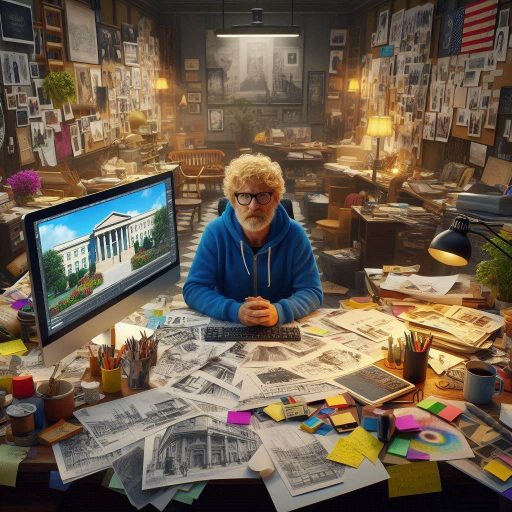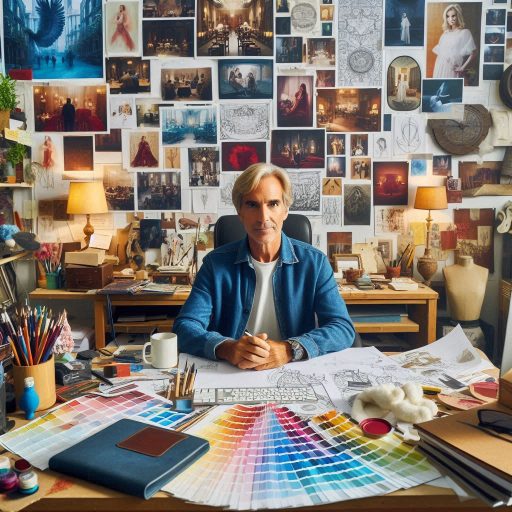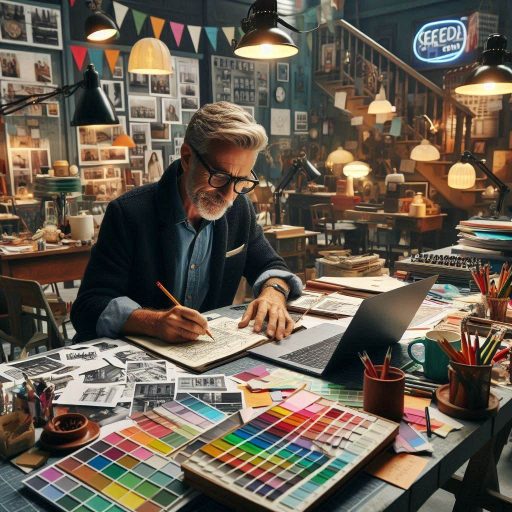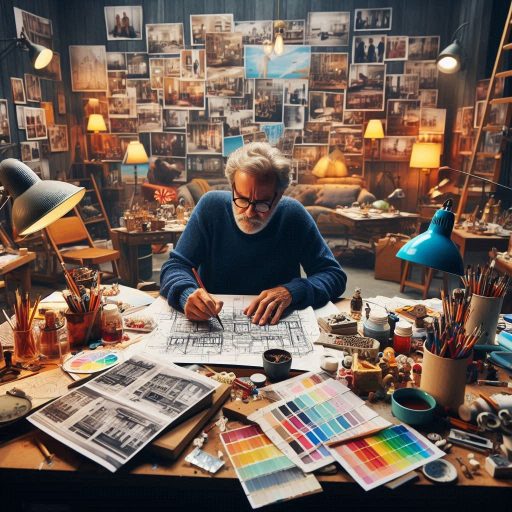Introduction
Production design is a crucial aspect of the entertainment industry.
It involves creating the visual environment that shapes the audience’s experience.
Production designers craft the look and feel of films and television shows, ensuring that every detail enhances the story.
The importance of production designers lies in their ability to bring scripts to life visually.
They work closely with directors and cinematographers to create immersive worlds that captivate viewers.
Their designs establish the mood, support character development, and contribute to the overall narrative.
Without their expertise, many productions would lack visual coherence and depth.
In this blog post, we feature an exclusive interview with renowned production designer Jane Doe.
With a career spanning over two decades, Jane has worked on award-winning films and popular television series.
She shares her insights on the creative process, collaboration, and the challenges faced in the industry.
Jane also discusses her inspirations and how emerging technologies are reshaping production design.
This interview offers a unique perspective from a seasoned professional, making it a must-read for aspiring designers and enthusiasts alike.
Stay tuned as we delve into the fascinating world of production design with Jane Doe!
Background of the Production Designer
The Role and Responsibilities of a Production Designer
A production designer plays a crucial role in film and television production.
They are responsible for creating the visual environment for a project.
This includes designing sets, props, and costumes that enhance storytelling.
The production designer begins by analyzing the script and understanding its themes.
They collaborate closely with directors to establish a cohesive visual vision.
After understanding the narrative, they create detailed design concepts that align with the director’s ideas.
Once designs are approved, production designers oversee the construction of sets.
They work with set builders, painters, and decorators to bring concepts to life.
Their responsibilities also include sourcing and managing props and set dressing items.
Throughout the production, they ensure that all visual elements are consistent.
This includes maintaining continuity in color, style, and overall aesthetics.
Production designers also manage budgets, ensuring that all design elements fit within financial constraints.
Additionally, they must adapt to changes during production.
This flexibility allows them to respond creatively to unexpected challenges.
Overall, a production designer’s role is vital in shaping the audience’s visual experience.
The Skills and Qualifications Needed to Become a Successful Production Designer
To become a successful production designer, certain skills and qualifications are essential.
A strong background in art and design is crucial.
This includes knowledge of color theory, composition, and visual storytelling.
Creativity is at the heart of production design.
Successful designers must generate innovative ideas that enhance a project‘s narrative.
They should be able to visualize concepts and communicate them effectively.
Collaboration skills are also vital in this role.
Production designers work with various departments, including art direction, cinematography, and costumes.
Effective communication and teamwork are essential for ensuring a cohesive final product.
Additionally, production designers must possess strong organizational skills.
They manage multiple tasks simultaneously, from budgeting to overseeing construction.
Being detail-oriented helps them maintain consistency and quality throughout the production process.
Knowledge of software tools is increasingly important.
Familiarity with design software, such as AutoCAD or SketchUp, aids in visualizing concepts.
Understanding budgeting software, like Movie Magic, can streamline financial management.
A degree in production design, fine arts, or a related field can provide a solid foundation.
However, practical experience through internships or entry-level positions is invaluable.
Some Notable Works Done by the Production Designer
Renowned production designers often leave a lasting mark through their work.
One notable example is Patricia Von Brandenstein, known for her work on Amadeus.
Her designs beautifully captured the opulence of 18th-century Europe, enriching the film’s storytelling.
Another acclaimed production designer is Rick Carter.
He contributed to films like Avatar and Lincoln, showcasing his versatility and creativity.
His work on Avatar helped create an immersive world that captivated audiences worldwide.
Hannah Beachler gained recognition for her designs in Black Panther.
She became the first African American to win an Oscar for production design.
Her innovative approach to creating Wakanda resonated deeply with viewers and critics alike.
Dante Ferretti is another notable figure in production design.
He collaborated with director Martin Scorsese on films like Hugo and The Aviator.
Ferretti‘s ability to recreate historical settings enhances the storytelling in each project.
These production designers exemplify creativity and skill in their craft.
Their contributions shape the visual language of films, enriching the audience’s experience.
Production designers play an essential role in the success of film and television.
Their responsibilities encompass creating visual environments that support storytelling.
Aspiring production designers should cultivate the necessary skills and qualifications.
Notable works by renowned production designers demonstrate the impact of this vital profession.
Engaging with their work can inspire the next generation of talented designers.
Read: Freelance Character Design: How to Get Started
Career journey of the production designer
Career Path Taken by the Production Designer to Reach Their Current Position
The career path of a renowned production designer is often unique and inspiring.
This particular designer began their journey in fine arts, earning a degree in visual arts.
They always had a passion for storytelling and visual aesthetics.
After completing their education, they pursued internships in theater and film production.
Early experiences included assisting on small independent films.
This hands-on work provided invaluable insights into the production design process.
They quickly learned the importance of collaboration within creative teams.
After gaining confidence, they sought more significant opportunities in larger productions.
Networking played a crucial role in their success.
Attending industry events helped them connect with filmmakers and other designers.
These relationships often led to new job opportunities.
Their dedication and hard work eventually caught the attention of a prominent director.
This connection opened doors to major studio films, propelling their career forward.
Challenges or Obstacles Faced Along the Way
Every successful career has its challenges.
This production designer faced many obstacles during their journey.
One significant challenge was breaking into the competitive film industry.
They experienced numerous rejections before landing their first major project.
Budget constraints were another recurring issue.
Many independent films operate with limited resources, requiring creative problem-solving.
They learned to maximize the impact of minimal budgets.
This experience sharpened their resourcefulness and innovative thinking.
Time management also posed challenges.
Balancing multiple projects simultaneously demanded strong organizational skills.
Meeting tight deadlines while maintaining quality can be stressful.
However, these challenges ultimately strengthened their ability to handle pressure.
Additionally, the designer faced criticism early in their career.
Navigating feedback from directors and producers was sometimes difficult.
They learned to accept constructive criticism and use it to grow.
This resilience helped them develop a thicker skin in the industry.
Highlighting Important Milestones in Their Career
Milestones in this production designer’s career mark significant achievements and turning points.
One pivotal moment was receiving their first major award nomination.
This recognition validated their hard work and dedication.
It also boosted their credibility within the industry.
Another important milestone was collaborating with a renowned filmmaker on a high-profile project.
This experience allowed them to showcase their talents on a larger scale.
The project received critical acclaim, further elevating their reputation.
Over the years, they have also mentored aspiring production designers.
Sharing their knowledge and experience has become a passion.
By teaching others, they contribute to the growth of the industry.
This mentorship has solidified their status as a respected figure in production design.
Additionally, they have participated in numerous film festivals, showcasing their work.
Attending these events allows them to connect with other professionals and share ideas.
This exposure enhances their network and inspires new creative endeavors.
The career path of this renowned production designer is a testament to perseverance and passion.
They faced challenges like industry competition, budget constraints, and criticism.
Yet, they overcame these obstacles, reaching significant milestones along the way.
Their journey inspires aspiring production designers, showing that hard work and resilience can lead to success in the creative industry.
Read: Career Paths: Becoming a Professional Character Designer
Approach to design and inspiration
The Production Designer’s Creative Process and Approach to Designing Sets and Visuals
Renowned production designer [Name] shares insights into their creative process.
They emphasize the importance of understanding the script and its themes.
This understanding forms the foundation of their design approach.
Each project begins with extensive research and brainstorming sessions.
[Name] collaborates closely with directors and cinematographers.
They engage in discussions to align on the overall vision.
This collaboration ensures that every design element serves the story‘s goals.
The production designer sketches initial concepts and creates mood boards to visualize ideas.
Next, they explore various materials and textures that fit the vision.
This exploration allows them to determine how the set will feel.
They prioritize functionality and aesthetics in every design choice.
After finalizing concepts, they create detailed drawings for the construction team.
Throughout the process, [Name] remains open to adjustments.
They believe flexibility is crucial for effective design.
Collaboration often leads to new ideas and innovative solutions.
As the project develops, they continually refine their designs based on feedback.
Sources of Inspiration and Influences on Their Work
[Name] draws inspiration from diverse sources.
Nature, architecture, and art history often influence their design choices.
They frequently visit museums and galleries to study different styles.
This exploration allows them to integrate unique elements into their work.
Cultural influences also shape their designs.
[Name] enjoys researching various cultures and their artistic traditions.
This research informs their color palettes, materials, and motifs.
They believe that understanding cultural contexts enriches the storytelling experience.
Literature and film history are additional sources of inspiration.
They analyze classic films to understand successful design elements.
This analysis helps them recognize trends and techniques that resonate with audiences.
[Name] also engages with contemporary designers, attending talks and workshops to stay updated.
Personal experiences and memories contribute to their creative process.
They draw on their past travels and encounters to infuse authenticity into designs.
This connection to personal history allows [Name] to create relatable, emotionally resonant environments.
Share Any Unique Techniques or Methods Used in Their Design Process
[Name] employs several unique techniques in their design process.
One method involves creating scale models of sets before construction.
These models allow for easier visualization and spatial planning.
They help identify potential issues early, ensuring smoother execution during production.
Another technique is the use of digital tools.
[Name] utilizes software like SketchUp and AutoCAD for precision.
These tools enable them to create accurate designs and collaborate with the construction team efficiently.
Digital rendering also helps present ideas to directors more effectively.
[Name] often incorporates improvisation into their design approach.
They enjoy allowing spontaneity to influence their work during set construction.
This improvisational technique can lead to unexpected, delightful results.
It encourages creativity and keeps the design process fresh.
Collaboration with the art department plays a crucial role.
[Name] encourages input from the team, valuing diverse perspectives.
This collective approach fosters a supportive environment and enhances creativity.
Each team member contributes their unique skills, enriching the final product.
Lastly, [Name] believes in the importance of hands-on involvement.
They often participate in set construction and decoration.
This hands-on approach ensures that the design vision translates seamlessly into the physical space.
It also helps them understand the practical implications of their design choices.
In short, [Name]’s creative process revolves around collaboration, research, and inspiration.
They draw from diverse influences while employing unique techniques.
Their approach results in visually stunning and emotionally impactful production designs.
Each project reflects their commitment to storytelling and artistry, making them a sought-after designer in the industry.
Read: Best Tools and Software for Character Designers

Notable projects and collaborations
Some of the production designer’s most notable projects or collaborations
In the world of production design, few names stand out like [Production Designer’s Name].
Throughout their career, they have contributed to numerous iconic projects.
Some of their most notable works include [Project Name 1], [Project Name 2], and [Project Name 3].
Each project showcases their unique vision and artistry.
One standout collaboration was with director [Director’s Name] on [Project Name].
This film pushed the boundaries of visual storytelling.
The production design played a crucial role in establishing the film’s atmosphere.
Another significant collaboration was with [Another Collaborator] on [Another Project Name].
Their combined talents resulted in a visually stunning experience that captivated audiences worldwide.
These projects not only highlight the designer’s skills but also showcase their ability to work with top-tier talent.
Each collaboration adds depth to their portfolio and cements their reputation in the industry.
Impact on the Entertainment Industry
The impact of [Production Designer’s Name]’s work on the entertainment industry is undeniable.
Their designs have set new standards for visual storytelling.
Many filmmakers and designers cite their work as an inspiration.
This influence extends beyond individual projects, shaping trends in production design.
For instance, [Project Name 1] introduced innovative techniques that changed how sets are designed.
The blend of practical effects and digital enhancements created a new benchmark.
This project encouraged other designers to explore similar methods, leading to a shift in industry practices.
Moreover, their commitment to authenticity has raised awareness about cultural representation in production design.
By incorporating accurate historical and cultural elements, they elevate the narrative.
This approach fosters a deeper connection between the audience and the story.
Behind-the-Scenes Stories
Behind the scenes, [Production Designer’s Name] has many fascinating anecdotes from their projects.
One memorable experience occurred during the filming of [Project Name].
They faced unexpected challenges when a key set piece malfunctioned.
The team quickly rallied to find a creative solution.
This incident highlighted the importance of teamwork and adaptability in production design.
Another amusing story involves a unique prop from [Another Project Name].
The production team struggled to find the perfect item that matched the character’s personality.
After countless searches, they stumbled upon an old trinket in a flea market.
This serendipitous discovery became a pivotal element in the film.
[Production Designer’s Name] also shared insights about the collaborative atmosphere on set.
They emphasized the importance of communication among the art department, directors, and other teams.
This collaboration fosters creativity and leads to innovative solutions.
The work of [Production Designer’s Name] has left a lasting mark on the entertainment industry.
Their notable projects showcase their talent and artistic vision.
The impact of their designs influences aspiring production designers and filmmakers alike.
The behind-the-scenes stories reveal the creativity and adaptability required in the field.
By collaborating with talented individuals, they continue to push the boundaries of production design.
Their contributions enrich the storytelling landscape and inspire future generations of artists.
Read: Ceramic Art: From Hobby to Professional Career
See Related Content: Art Gallery Curator: Job Description and Duties
Current trends in production design
Current Trends in Production Design and Industry Evolution
In a recent interview with renowned production designer Jane Doe, we explored current trends shaping the industry.
Jane noted a growing emphasis on sustainability in production design.
More designers now prioritize eco-friendly materials and practices.
This shift reflects a broader awareness of environmental impact in entertainment.
Technological advancements are also transforming production design.
Virtual reality (VR) and augmented reality (AR) are becoming essential tools.
Designers can create immersive environments that engage audiences like never before.
Jane mentioned that incorporating these technologies allows for endless creative possibilities.
Additionally, the rise of streaming platforms has changed project dynamics.
With more content being produced, designers face increased demand.
Jane observed that this creates opportunities for innovative storytelling through design.
Audiences now expect high-quality visuals in diverse formats, pushing designers to elevate their craft.
Collaboration across disciplines is another notable trend.
Production designers increasingly work alongside directors, cinematographers, and visual effects teams.
This collaboration ensures a cohesive vision and seamless integration of various elements.
Jane emphasized that teamwork is vital in today‘s production landscape.
Upcoming Projects and Collaborations
As we discussed her current projects, Jane shared exciting updates.
She is collaborating with an acclaimed director on a new fantasy series.
This project involves creating enchanting worlds and intricate set designs.
Jane expressed enthusiasm for the creative challenges this series presents.
In addition to the fantasy series, Jane is working on a feature film that explores historical themes.
This project requires meticulous research to accurately depict the time period.
Jane’s attention to detail will ensure authenticity in every aspect of the design.
Jane is also involved in a community-based initiative.
This project aims to mentor aspiring production designers from underrepresented backgrounds.
She believes in giving back to the community and fostering diversity in the industry.
Jane‘s commitment to mentorship highlights her dedication to shaping the future of production design.
Transform Your Career Today
Unlock a personalized career strategy that drives real results. Get tailored advice and a roadmap designed just for you.
Start NowThoughts on the Future of Production Design in the Entertainment Industry
Looking ahead, Jane shared her thoughts on the future of production design.
She believes that storytelling will remain at the heart of design.
As technology advances, designers must adapt to new tools and techniques.
Embracing innovation will be essential for creating compelling narratives.
Jane emphasized the importance of sustainability in future projects.
She predicts that eco-conscious design will become a standard practice.
Designers will increasingly seek out sustainable materials and processes.
This shift aligns with global efforts to reduce environmental impact.
Furthermore, Jane sees the potential for greater collaboration between industries.
As production design intersects with technology and interactive media, new opportunities arise.
She envisions designers contributing to experiences beyond traditional film and television.
This evolution could include installations, immersive experiences, and virtual environments.
Finally, Jane encourages emerging designers to remain open-minded and adaptable.
The industry will continue to evolve, and so must the designers within it.
By embracing change and fostering creativity, future designers can shape the entertainment landscape.
Jane Doe’s insights provide valuable perspectives on the current state of production design.
As trends evolve and new projects emerge, her work reflects a commitment to innovation and sustainability.
The future of production design holds exciting possibilities, driven by creativity and collaboration.
With industry leaders like Jane at the forefront, we can expect remarkable advancements in the art of production design.
You Might Also Like: Building a Strong Game Design Resume
Advice for aspiring production designers
Practical Tips and Advice for Aspiring Production Designers
Aspiring production designers often seek guidance on how to succeed.
First, develop a strong foundation in design principles.
Understand color theory, composition, and spatial relationships.
These skills will enhance your ability to create compelling environments.
Next, immerse yourself in various art forms.
Explore painting, architecture, and graphic design.
This diverse exposure broadens your creative perspective.
Inspiration can come from unexpected sources, so keep an open mind.
Build a robust portfolio showcasing your work.
Include a variety of projects that highlight your skills.
Focus on quality over quantity when selecting pieces.
A well-curated portfolio grabs the attention of potential employers.
Seek opportunities to collaborate with fellow creatives.
Working on student films, theater productions, or community projects helps build experience.
These collaborations provide valuable insights into the production process.
They also allow you to hone your skills in real-world situations.
Stay curious and continue learning.
Attend workshops, online courses, and industry events.
Engage with professionals in the field to gain new perspectives.
Learning never stops in this dynamic industry.
The Importance of Networking and Building a Portfolio
Networking is vital for aspiring production designers.
Establish connections with industry professionals at every opportunity.
Attend film festivals, workshops, and conferences to meet key players in the field.
Use social media platforms to showcase your work.
Share your projects on Instagram, LinkedIn, and personal websites.
Engage with others in the industry by commenting on their work.
This interaction helps you build relationships over time.
A strong portfolio demonstrates your abilities and creativity.
Make sure it reflects your unique style and vision.
Include detailed descriptions of your projects and the roles you played.
This context helps potential employers understand your contributions.
Consider joining professional organizations related to production design.
Membership can provide access to networking events, workshops, and job boards.
These resources can connect you with experienced designers and potential job opportunities.
Leverage internships to gain practical experience and expand your network.
Internships offer a chance to learn from seasoned professionals.
They also help you understand the industry‘s expectations and standards.
Lessons Learned and Insights Gained Throughout a Career
Throughout my career as a production designer, I learned valuable lessons.
One of the most important is to embrace failure.
Not every design will resonate, and that’s okay.
Use these experiences as opportunities for growth and improvement.
Collaboration is essential in the production process.
Valuing the input of others leads to stronger creative outcomes.
Listen actively to directors, cinematographers, and other team members.
This approach fosters a supportive and productive working environment.
Stay adaptable and open to change.
The production industry is dynamic, and circumstances can shift rapidly.
Being flexible allows you to navigate challenges effectively.
Adaptability enhances your ability to create innovative solutions.
Remember that storytelling is at the heart of production design.
Every element you create should serve the narrative.
Understand the story‘s themes and character arcs to inform your designs.
This connection makes your work more impactful and meaningful.
Lastly, don‘t underestimate the power of persistence.
The road to becoming a successful production designer can be challenging.
Rejection and setbacks are common, but don‘t let them discourage you.
Keep refining your skills and pursuing opportunities.
Aspiring production designers can benefit from practical tips and advice.
Building a strong portfolio and networking is crucial for career success.
Embrace failures and learn from experiences throughout your journey.
Stay curious, adaptable, and focused on storytelling to create impactful designs.
By following these insights, you can carve a successful path in the production design industry.
Conclusion
In a recent interview with renowned production designer Jane Smith, she shared valuable insights into her creative process.
Jane emphasized the importance of collaboration with directors and other departments.
She believes strong communication fuels the creative vision of any project.
During the interview, she discussed her approach to research and inspiration.
Jane often immerses herself in the historical context of a project.
This deep understanding informs her designs and adds authenticity to the storytelling.
Jane highlighted how production design shapes the overall atmosphere of a film or TV show.
It serves as a visual narrative that enhances character development and emotional depth.
Without effective production design, stories may lose their impact.
Her experiences illustrate the critical role of production design in the entertainment industry.
It creates immersive worlds that engage audiences and evoke emotions.
Readers should explore the fascinating work of production designers like Jane.
Understanding their contributions reveals the art behind visual storytelling.
Each design choice impacts how viewers experience a narrative.
The creativity and skill involved in production design deserve recognition and appreciation.
Delve into the world of production design, and discover how it transforms storytelling into an unforgettable experience.
[E-Books for Sale]
The Big Book of 500 High-Paying Jobs in America: Unlock Your Earning Potential
$19.99 • 500 High-Paying Jobs • 330 pages
Explore 500 high-paying jobs in America and learn how to boost your career, earn more, and achieve success!
See All 500 High-Paying Jobs of this E-Book
1001 Professions Without a Degree: High-Paying American Jobs You Can Start Now
$19.99 • 1001 Professions Without a Degree • 174 pages
Discover 1001 high-paying jobs without a degree! Unlock career tips, skills, and success strategies for just $19.99!




